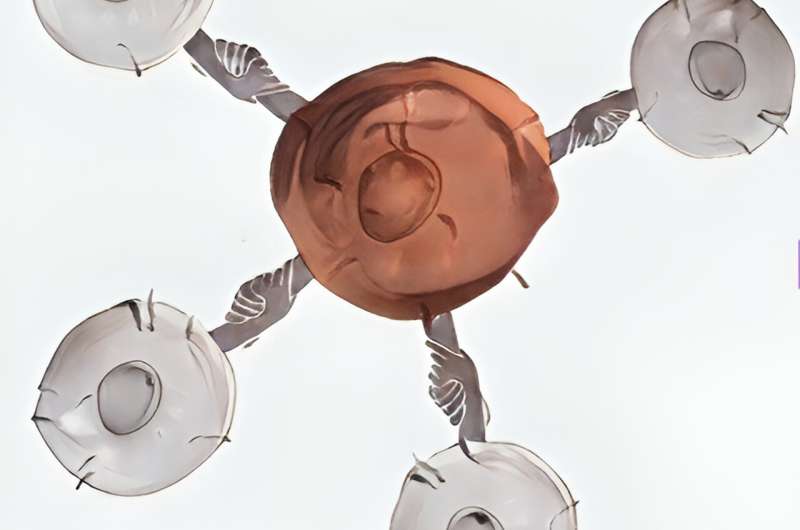For sufferers with early-stage breast most cancers, there’s a 7% to 11% probability of relapse inside 5 years after receiving preliminary therapy, and this charge may be increased for sufferers with extra superior phases of the most cancers. Whereas chemotherapy goals to get rid of all most cancers cells, a few of them might evade therapy and survive, ensuing within the recurrence of the most cancers.
In a research that spanned over ten years, Analysis Assistant Professor Leong Sai Mun from the NUS Centre for Most cancers Analysis (N2CR) and the Division of Pathology on the Yong Lavatory Lin Faculty of Medication, Nationwide College of Singapore (NUS Medication) and his analysis crew sought to uncover the explanations for why some breast most cancers tumors survive chemotherapy.
In inspecting tumor and blood samples from 63 sufferers with breast most cancers throughout totally different phases, in addition to lab-grown breast most cancers cells and laboratory fashions, the crew discovered that most cancers cells with excessive expression of a sure molecule—a small non-coding RNA often known as miR-125b—cooperate with surrounding most cancers cells to permit the latter to develop and resist chemotherapy.
Opposite to the broadly held perception that most cancers cells are solely self-serving and pushed by their very own survival, this breakthrough research confirms that they show altruistic conduct to assist different most cancers cells thrive by sacrificing their very own talents to multiply. This discovery reveals that disrupting such cooperation could possibly be key to growing simpler therapies for breast most cancers.
Asst Prof. Leong stated, “Our analysis has recognized these cooperative behaviors between most cancers cells, which therapy should goal particularly, for them to be destroyed extra successfully. For instance, therapy strategies have to include mechanisms that forestall the encompassing most cancers cells from responding and benefitting from the ‘self-sacrificing’ cells.”
Printed in Molecular Most cancers, the analysis paper describes the complicated signaling course of inside these altruistic cells which ends up in the tumor’s general resistance to therapy.
Via a signaling pathway often known as NF-κB, altruistic most cancers cells exhibiting excessive miR-125b expression endure lowered proliferation. Paradoxically, this identical signaling course of prompts these altruistic most cancers cells to launch substance—proteins often known as IGFBP2 and CCL28—which fosters larger tolerance to chemotherapy throughout all the most cancers tumor.

“Eradicating these altruistic most cancers cells could be a potential therapy technique. Nevertheless, we might have to contemplate the persistence of those cells. We discovered that regardless of the self-sacrifice, the altruistic most cancers cells can regenerate from the non-altruistic ones and stay throughout the tumor inhabitants at a low but constant frequency,” added Dr. Muhammad Sufyan Bin Masroni, first creator of the research, and analysis fellow from the Division of Pathology at NUS Medication.
The analysis crew additionally concerned collaborators from different departments of NUS Medication; the NUS School of Science; Nationwide College Hospital (NUH); Nanyang Technological College, Singapore (NTU); Singapore Institute for Medical Sciences (SICS) and Institute of Molecular and Cell Biology (IMCB) on the Company for Science, Expertise and Analysis (A*STAR); MiRXES; CellSievo; Raffles Hospital; Tucker Medical; and the Pennsylvania State College, United States.
Affiliate Professor Mikael Hartman, Head and Senior Guide, Division of Basic Surgical procedure (Breast Surgical procedure), Division of Surgical procedure, NUH, and co-author of the research, stated, “This analysis research supplies necessary insights into the intricate biology of breast most cancers, providing a promising avenue for higher comprehension of its behavioral features, prognosis, and potential therapy targets.”
Via the research, the crew demonstrated complicated interactions amongst most cancers cells, which resemble social bonds noticed in micro-organisms and animals, corresponding to bees and ants. The crew additionally confirmed that sure most cancers pathways, that are at present acknowledged as separate mechanisms that both suppress or develop tumors, can happen as simultaneous occasions throughout the altruistic most cancers cells, regulating the fragile steadiness of cooperative social conduct throughout the tumor.
Past most cancers therapy, the elemental mechanism of such altruistic conduct has broader implications for the understanding of the interaction between social organisms in different illnesses, corresponding to these pushed by micro organism or viruses.
Extra data:
Muhammad Sufyan Bin Masroni et al, Dynamic altruistic cooperation inside breast tumors, Molecular Most cancers (2023). DOI: 10.1186/s12943-023-01896-7
Quotation:
Breast most cancers cells’ self-sacrificial conduct uncovered as potential reason behind relapse (2023, December 29)
retrieved 3 July 2024
from https://medicalxpress.com/information/2023-12-breast-cancer-cells-self-sacrificial-behavior.html
This doc is topic to copyright. Other than any honest dealing for the aim of personal research or analysis, no
half could also be reproduced with out the written permission. The content material is offered for data functions solely.

